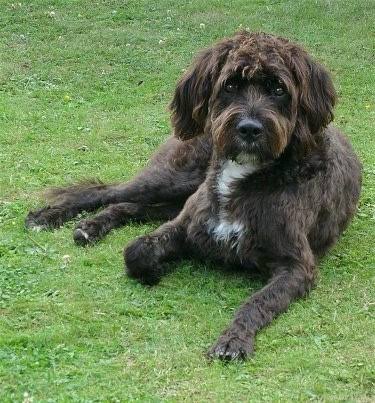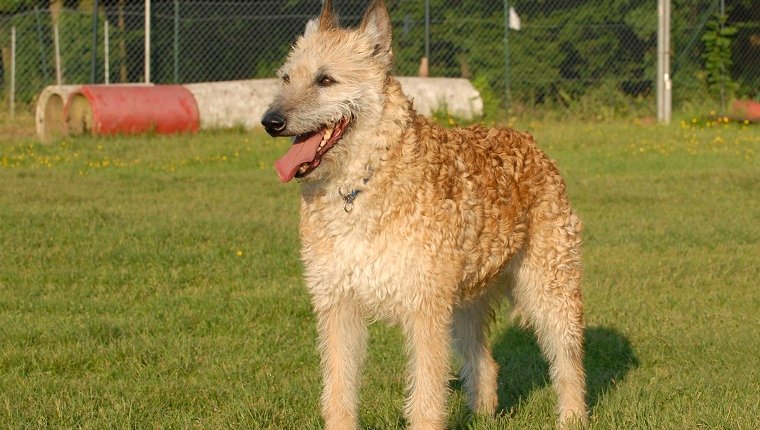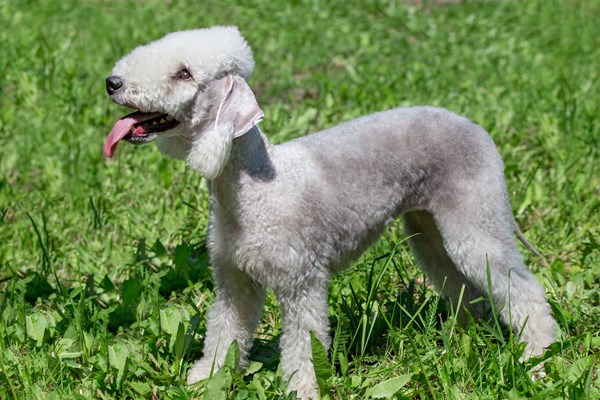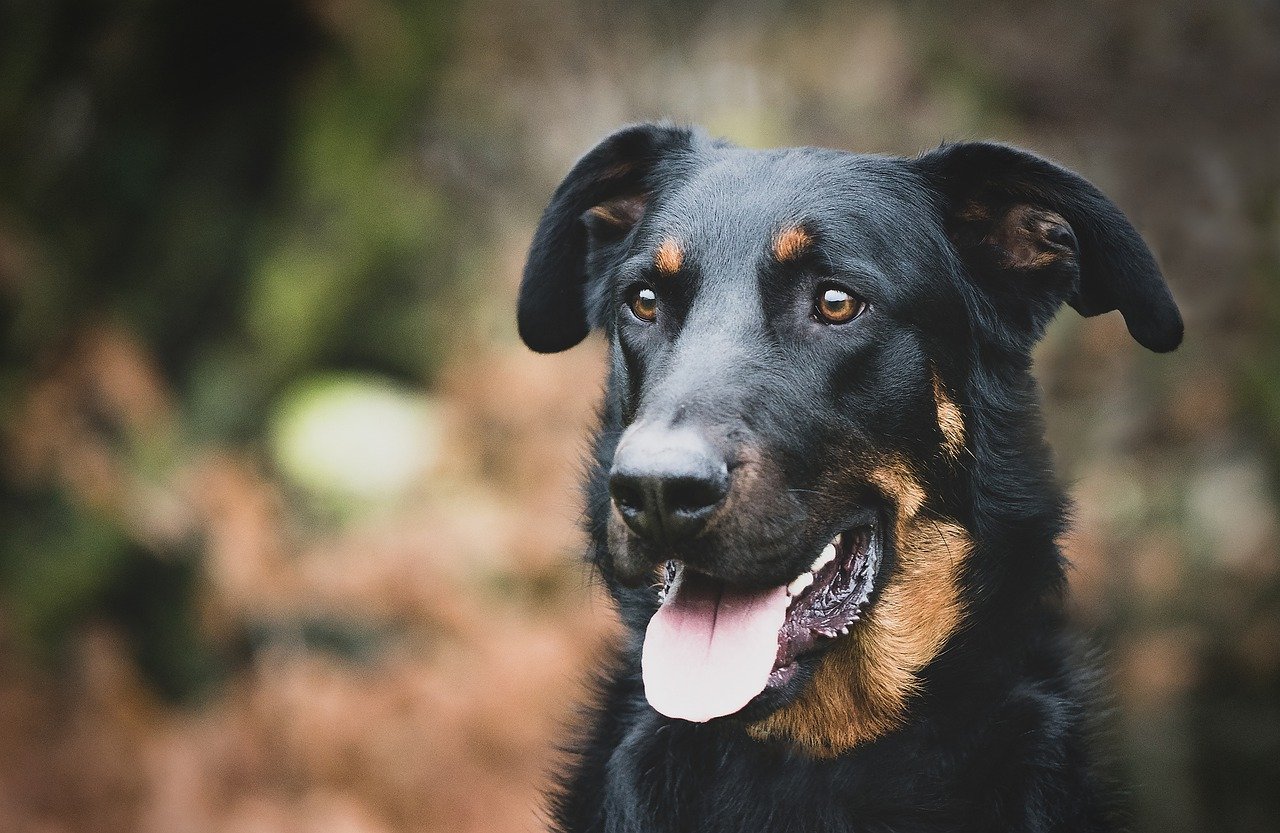Boxerdoodle Dog Overview
The Boxerdoodle is a cross between a Boxer and a Poodle. They were developed during the last decade or two, and little information is available regarding their origins.
A Boxerdoodle combines seriousness and nobility with a lively disposition. It is a patient and calm dog that takes its job very seriously.
Its preferred pastime is relaxing with the family. While the majority of these dogs are devoted and loyal to their handlers, they remain reserved towards strangers.
They are fiercely protective of their family and territory and can become aggressive when provoked or perceive threat. Shouting at these dogs will enrage them, as they are extremely sensitive.
Boxerdoodle Highlights

- Boxerdoodles are a crossbreed dog. They are not purebred Boxers or Poodles like their parents.
- Boxerdoodles exist in virtually any color you can imagine, though shades of brown are the most frequent.
- The Boxerdoodle’s coat is often curly and wavy, however it can range in length from short to long. You must make a commitment to brushing it at least every other day.
- Children and Boxerdoodles get along well. Simply follow the standard standards for socialization and training both children and pets from an early age.
- When it comes to existing home pets, this mixed breed must be well socialized before being allowed to interact with them. They may thrive as a solitary pet in the home.
- Boxerdoodles are clever, energetic, and relatively simple to train. They’ll have a blast accompanying you on hikes and lengthy walks.
- These dogs are sociable and kind. They make wonderful family pets.
Boxerdoodle Breed Features & Ratings:
Rated base on a 5 Star Scale
ENERGY LEVEL: 4 Star
EXERCISE REQUIREMENTS: 4 Star
PLAYFULNESS: 5 Star
AFFECTION LEVEL: 4 Star
FRIENDLINESS TO DOGS: 4 Star
FRIENDLINESS TO OTHER PETS: 3 Star
FRIENDLINESS TO STRANGERS: 3 Star
WATCHFULNESS: 5 Star
EASE OF TRAINING: 4 Star
GROOMING REQUIREMENTS: 2 Star
HEAT SENSITIVITY: 3 Star
VOCALITY 5 Star
Boxerdoodle Characteristics:

- Dog Breed Group: Companion Dogs
- Height: 10 to 15 inches
- Weight: 12 to 70 pounds
- Life Span: 10 to 12 years
- Type: Crossbreed
- AREA OF ORIGIN: Germany
- DATE OF ORIGIN: Unknown
- OTHER NAMES: Poodle-boxer mix, boxer doodle
- Temperament: Affectionate, loyal, active, protective, cheerful
- Activities: Obedience, Agility
- Color: Can be solid colored in fawn, black, red, white shades; brindled or parti-colored with flash markings is also possible
- Litter Size: 2 to 4 puppies
- Puppy Prices: $1200-$1500
Boxerdoodle Health:
Boxerdoodles are generally considered to be healthy dogs; nonetheless, the breed is susceptible to some of the same health problems as Boxers and Poodles.
As is always the case, it is critical to arrange routine wellness checks with your dog’s veterinarian.
Several of the more prevalent health problems encountered by Boxerdoodles include the following:
- Bloat
- Cardiomyopathy
- Entropion
Boxerdoodle Grooming:
When you encounter a Boxerdoodle, you’ll notice that they come in virtually any color you can imagine—though variations of brown are typically the most prevalent.
The Boxerdoodle’s coat is often curly and wavy, however it can range in length from short to long.
When it comes to grooming, you’ll need to invest in a wire brush and make a commitment to brushing the mixed breed’s coat at least every other day.
Otherwise, you may need to contact the veterinarian or groomer to deal with any mats that develop. By and large, the Boxerdoodle is considered a climate-adaptive breed.
However, due to the breed’s wide variety of size and coat length, you’ll need to assess your living situation on a dog-by-dog basis.
As always, offer a proper dog coat if the weather appears to be getting too cold.
Ensure that shade and fresh water are always available during outdoor play and activity sessions throughout the hotter months.
Boxerdoodle Exercise:
Although it may live in an apartment, it must be taken out periodically for play and training.
A regular hour’s stroll, jog, or play session with toys would suffice.
Their activities would be best conducted in an open location, such as a medium-sized yard with fencing.
Boxerdoodle Training:
Due to the boxerdoodle’s sensitive, intelligent, and bright personality, it is easily managed and trained, especially with prizes and treats.
Because it is resistant to harsh treatment, employing harsh and repressive techniques of training may backfire and breed resistance.
By introducing the puppies to other dogs, you can teach them to be obedient and socialize them. Maintain constancy, fairness, and firmness while training the pet.
Boxerdoodle Food and Nutrition:
An excellent Boxerdoodle diet should be tailored to the specific needs of a small, medium, or large dog. However, the breed is high-energy in all circumstances.
Boxerdoodles must adhere to a healthy diet, since excessive eating can result in weight gain and associated health problems, even more so when enough activity is not provided.
As with all dogs, the Boxerdoodle’s nutritional requirements will change as they mature into adulthood and continue to do so into their senior years.
You should consult your veterinarian on your Boxerdoodle’s food, as there is just too much variety between individual dogs in terms of weight, energy, and health to provide a specific recommendation.
Boxerdoodle Temperament and Personality:
When people discuss their Boxerdoodles, they frequently begin by remarking on their gregarious and pleasant nature.
They will instantly become a part of the family, and their playful personality means they thrive in an active environment, which enables them to build strong ties with children.
If you’re an energetic person who enjoys the outdoors, your Boxerdoodle will nearly always be up for hiking and trekking with you.
If you happen to stumble across a body of water, don’t be shocked if your Boxerdoodle spends the afternoon swimming.
Additionally, the mixed breed will keep you entertained with their crazy and amusing activities. The second characteristic that people comment on is the intelligence of Boxerdoodles.
There is no doubt that these dogs are intelligent and extremely easy to train, provided that correct socialization and training are followed.
Otherwise, you may end up with a dog who is extremely stubborn.
Boxerdoodle Care/Upkeep:
The Boxerdoodle is a high-energy dog with high exercise requirements. You should aim for approximately an hour of exercise every day, and you should walk at a fast speed.
Outdoor time, in an ideal world, would also include opportunities for swimming, fetch activities, and perhaps agility training.
Because this is a smart dog, it is critical to keep them cognitively and physically stimulated.
Apart from exercise, owners of Boxerdoodles must pay great attention to their dog’s ears and eyes, cleaning and inspecting them at least weekly.
Due to the dog’s exercise requirements, you’ll also want to plan routine nail clippings—ask your veterinarian for assistance and guidance if you’re unclear how to do so.
Following any prolonged outdoor excursions, it’s also a good idea to inspect the mixed breed’s paw pads for any signs of damage.
Additionally, check their ears for debris or parasites and clean them as prescribed by your veterinarian.
Boxerdoodle Relationship with Children and Other Pets
Children and Boxerdoodles get along well. Simply follow the standard standards for socialization and training both children and pets from an early age.
Additionally, the mixed breed frequently does better with older children, while Boxerdoodles are excellent family dogs in general.
When it comes to existing family pets, these canines must be properly socialized before being allowed to interact with them. In an ideal world, the Boxerdoodle will be adopted into a pet-free household.
Finally, early socialization is critical with this breed. When you bring your Boxerdoodle home to your family, make sure to reward them for excellent behavior and to follow a suitable training regimen.
Boxerdoodle Names
| Rank | Boy Names | Girl Names |
| 01 | Max | Bella |
| 02 | Cooper | Daisy |
| 03 | Charlie | Abbie |
| 04 | Tucker | Molly |
| 05 | Buddy | Bailey |
| 06 | Oscar | Coco |
| 07 | Bentley | Zoe |
| 08 | Milo | Sophie |
| 09 | Bailey | Katie |
| 10 | Louie | Penny |
All About Boxerdoodle
The Boxer Poodle cross is a designer dog that was bred to have a low-shedding coat with each parent’s winning personality. However, we’ll discuss its temperament later.
This uncommon hybrid, like the Poodle and Boxer, is of German ancestry.
According to some, the Poodle originated in France in the 1500s, but the Germans swiftly swooped in and coined the moniker Pfudel.
Despite the illustrious history of its parents, the Boxer Poodle Mix was produced within the previous two decades. It is a relatively new breed.
To ascertain the Boxerdoodle’s size, we must first examine the Poodle genes. Poodles are classified into three sizes: standard, miniature, and toy.
However, given the Boxer’s size range of 22 – 25 inches (57 – 63 cm), we may assume that all Boxer Poodle hybrids will be on the large side.
At the shoulder, the average Poodle Boxer measures between 10 and 25 inches (25.5 – 63.5 cm). Thus, there is a huge margin.
Its affable, faithful, and loving disposition make it a great companion dog. It can be used as a therapy dog to bring comfort and affection to the sick and elderly if properly trained and socialized at a young age.
It gets along well with children and other family pets. It possesses the necessary energy and vigor for some difficult tasks, but otherwise remains patient and easygoing.
Because it is protective of its family and naturally reserved among outsiders, it does an excellent job of defending its territory and family from danger.
Boxerdoodle History:
The Boxerdoodle is one of the more recent mixed dog breeds, and its exact origins are unknown. Best predictions indicate that the breed emerged in the last decade.
When it comes to its Poodle ancestors, this is a breed that dates all the way back to ancient Egypt. Following that, the Poodle developed a following in France as a duck hunting dog.
On the Boxer side, the breed originated in the nineteenth century as a working farm dog and a combat dog.
Their fighting instincts have been eliminated, and they now make lovely, caring friends for any family.
Although the Boxerdoodle has gained popularity as a designer dog breed, many of them end up in shelters. Therefore, if you’re considering adopting a Boxerdoodle, contact your local rescue groups and shelters.
Where to Adopt Boxerdoodle:
Due to their mixed breed status, it may be difficult to locate a breed-specific rescue for Boxerdoodles.
However, you may wish to contact breed-specific rescues such as Boxer or Poodle, as they frequently care for mixed breeds as well.
Listed here are some possible rescues:
- Green Acres Boxer Rescue
- Carolina Poodle Rescue
More Dog Breeds and Further Research:
If you want to adopt or bring a dog into your home, consider doing research about these related breed.
Boxerdoodle Fun Facts
- The Boxerdoodle is a cross of a purebred Boxed and a purebred Poodle, also known as the Boxerpoo or Boxer Poodle Mix.
- Boxer Poodle Mix was only developed within the last two decades.
- This rare mix is of German descent, just like the Poodle and Boxer.
Frequently Asked Questions (FAQs):
The Boxerdoodle makes for an exceptionally playful and super friendly dog who can become a great addition to a family.
In order to perform such superhero tasks, the Boxerdoodle must be taken care of properly. Grooming: luckily for you, this mix is considered hypoallergenic and sheds minimally. It’s a great choice for owners with allergies.




